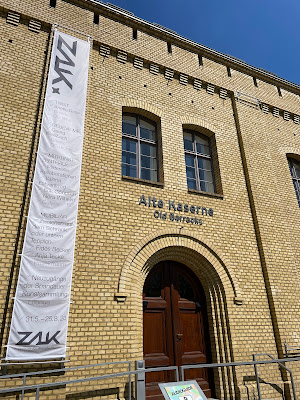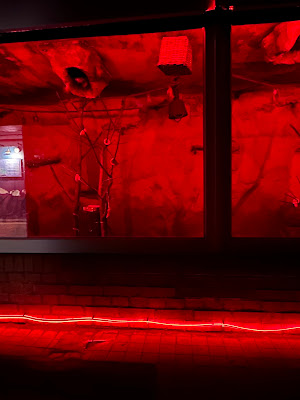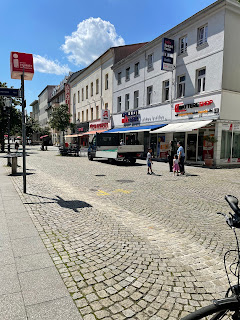Berlin - We took the S Bahn to Spandau city about 1hr from our train station.
Spandau, one of Berlin’s largest boroughs, has a wealth of history to explore. Its roots go back to the thirteenth century when it was founded as a medieval fortress town. Down the centuries, it has experienced many changes – and the traces are evident everywhere.
The old fortified tower, which is incidentally the oldest building in Berlin, stands in the middle of the Zitadelle, a square fortress built in the 16th century. It is completely surrounded by water and is one of the most important and best-preserved Renaissance fortresses in Europe.
The Citadel, the borough's most prominent historical monument, encapsulates this dynamic history and is a must-visit for anyone interested in Berlin's past.
Constructed in the 16th century, the Spandau Citadel is one of the best-preserved Renaissance fortresses in Europe. Its imposing bastion walls, which are up to four meters thick, and its vaulted corridors showcase the architectural prowess of the time.
The Citadel served as a strategic military fortification designed to withstand sieges and attacks. Over the years, it has played various roles, including serving as a prison and a military barracks.
 |
| Model of the Spandau Citadel |
 |
| Showcase of rifles |
Today, the Spandau Citadel is more than just a historical relic; it is a vibrant cultural hub. The Citadel houses several museums and exhibitions that offer insights into the history of the fortress and the broader historical context of Spandau and Berlin.
 |
| climb the stairs to reach the top of the Citadel |
 |
| Views from the top of the Citadel |
We explored the Julius Tower, which offers panoramic views of the surrounding area.
Musical Instrument workshop @ Spandau Citadel
The Glass workshop @ Spandau Citadel
Relaxing outside the workshops,
Alta Kaserne - The Old BarracksFrom its Renaissance fortifications to its role in more recent history, the Citadel provides a comprehensive look at the evolution of military architecture and urban development in Berlin.
The Provisions Depot
 |
| Lennin scuplture |
Exerzier Halle - the armoury |
| various ship cannons |
Spandau City History Museum
The Spandau City History Museum is located in the Arsenal. The permanent exhibition on the ground floor gives you an overview of the history of Spandau.
 |
| Linotype |
The Linotype machine is a "line casting" machine used in printing.
The Bat Haven
One of the unique aspects of the Spandau Citadel is its role as a sanctuary for bats. Every winter, the Citadel’s thick walls and vaulted corridors provide a hibernation haven for around 10,000 bats. This fascinating aspect adds an ecological dimension to the Citadel’s historical and cultural significance, making it a point of interest for wildlife enthusiasts and researchers.
We entered this infra-red damp chamber shielded by glass with bats flying in the caged glass chamber.
Spandau City
We walked around Spandau city and immersed in the atmosphere of this small town.
Lunch @ an authentic Italian restaurant with waiters speaking Italian. The dishes were delicious.
 |
| Magarita Pizza |
 |
| Spaghetti minced beef sauce |
 |
| Spaghetti carbonara |
Gotisches Haus Museum
After our lunch we visited the Gothic House is one of the most important secular, medieval monuments in the entire Berlin area. The late Gothic building was constructed in the second half of the 15th century.
 |
| Cargo carriage |
 |
| 16th century furniture |
 |
| Grandfather's clock |
 |
| Fire hydrant and fire bucket |
 |
| Model of Gotisches Haus |
 |
| St Nikolai in Berlin-Spandau |
The church was closed and we just took as outside photo of this church.
Kaiser Wilhelm Memorial Church
We took the train to this church is one of the famous churches in Berlin. Air raids in 1943 damaged the church so badly that the top of the main spire broke off and the roof collapsed. At the end of the war, the Allies were unwilling to rebuild it, since it had been a symbol of excessive national pride. The ruin stood as a constant reminder to Berliners of the horrors of war.
In honour of Wilhelm I, the first German Kaiser, his grandson Wilhelm II planned a magnificent church, which was built by Franz Schwechten between 1891 and 1895 in the Neo-Romantic style. With five spires, the bombastic design reflected the tastes of the time and that of the Kaiser.
The church bells were the second biggest in Germany after Cologne, and when the church was inaugurated, the five bells rang so loudly that the wolves in the zoo started howling. During the Second World War, the chimes stopped and the five bells were melted down for munitions.
This iconic church was partially destroyed during World War II and now stands as a memorial to peace and reconciliation. The new church and the preserved ruins are a powerful reminder of the city's history.
World Clock on Alexanderplatz
The World Clock on Alexanderplatz consists of a cylinder with 24 corners standing on a column. Each segment schematically represent the 24 time zones of the Earth.
The most important names of the cities from the individual time zones are engraved on the aluminum plates.
Haribo store in Berlin
HARIBO’s success has not been limited to the German market: as a global market leader in fruit gummies and liquorice, HARIBO is now available in more than 120 countries around the world.















































































No comments:
Post a Comment